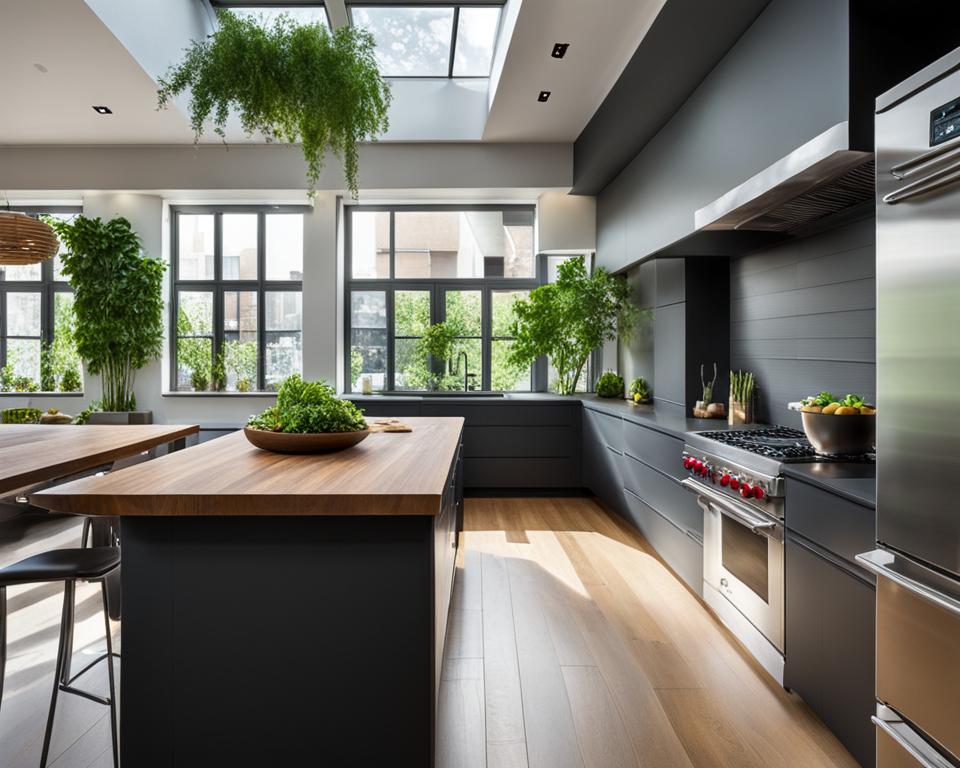Welcome to my blog where I share exciting ideas and tips on urban gardening, specifically focusing on creating a thriving garden in your kitchen. If you have limited space but a strong desire to connect with nature, grow your own food, and transform your home into a green oasis, you’ve come to the right place. In this article, I’ll explore the world of urban gardening, providing you with innovative urban garden ideas, valuable kitchen gardening tips, and insights into the benefits of this sustainable practice.
Create a Living Wall in Your Home
If you have limited space but still want to enjoy the benefits of a garden, creating a living wall is a fantastic solution. A living wall, also known as a vertical garden or green wall, allows you to grow plants vertically on an existing wall or a standalone structure. It not only adds a touch of nature to your home but also maximizes space utilization in small urban environments.
When designing your living wall, choose plants with small roots that can thrive on vertical surfaces. Some popular options include Money Plants, ferns, bromeliads, and spider lilies. These plants not only have compact root systems but also offer a variety of colors and textures, making your living wall visually appealing.
Creating a living wall is a great DIY project that you can complete with a few basic materials. You can attach a frame to your wall or build a standalone structure to support your plants. Ensure that the structure is sturdy and can hold the weight of the plants and the soil. Once your living wall is set up, regularly water and maintain your plants to ensure their health and vibrant growth.
Benefits of a Living Wall
- A living wall is an excellent solution for small space gardening, allowing you to enjoy the beauty of nature even in compact urban environments.
- It acts as a natural air purifier, improving the air quality in your home by filtering out pollutants and releasing oxygen.
- A living wall can also help insulate your home, providing an extra layer of protection against temperature fluctuations.
- It serves as a unique decorative element, adding visual interest and a sense of tranquility to your living space.
By creating a living wall in your home, you can transform any empty wall into a vibrant and green oasis. Embrace the beauty of nature and enjoy the benefits of gardening, even in the smallest of spaces.
Embrace One Pot Gardening
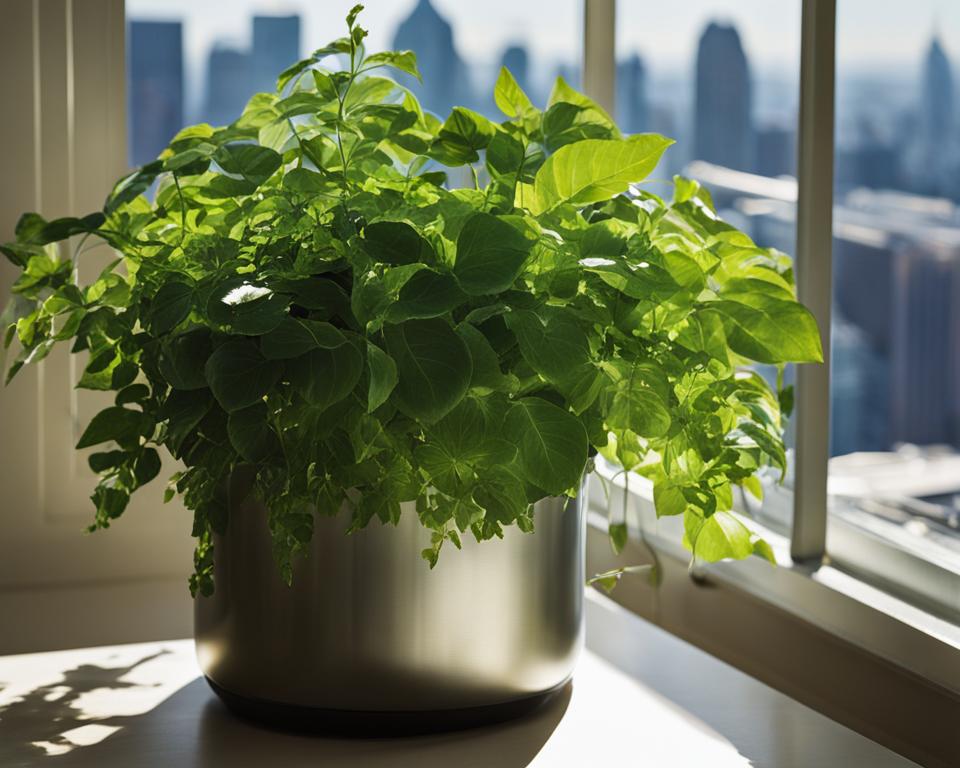
One pot gardening is an innovative and space-saving method that allows you to grow multiple plants in a single container. It is perfect for urban gardeners with limited space who still want to enjoy the benefits of a vegetable or herb garden. With one pot gardening, you can have a variety of plants thriving together, creating a beautiful and functional mini-garden.
The key to successful one pot gardening is choosing the right pot size. Ensure that it is large enough to accommodate the number of plants you want to grow, but not too large that it takes up too much space. Additionally, provide proper drainage to prevent waterlogging and ensure each plant has enough space to grow.
When it comes to plant selection, the possibilities are endless. You can grow a mix of vegetables, herbs, or even flowers in your one pot garden. Imagine having fresh basil, cherry tomatoes, and colorful marigolds all in one container. It not only adds beauty to your urban space but also provides you with fresh produce for your meals.
One pot gardening is a versatile and convenient way to bring nature into your urban home. Whether you have a small balcony, a sunny window sill, or a tiny patio, you can create a thriving garden with multiple plants in one pot. So, grab a container, choose your favorite plants, and start embracing the wonders of one pot gardening!
Recycle Bottles for a Vertical Garden
Looking for a creative and eco-friendly way to add greenery to your urban space? Why not try recycling bottles to create a vertical garden! This upcycled garden idea is not only a great way to repurpose plastic bottles but also a fantastic solution for those with limited space, such as a balcony garden.
To create a vertical garden using recycled bottles, start by collecting thick plastic bottles that are suitable for planting. Avoid using mineral water bottles, as they may not be sturdy enough. Clean the bottles thoroughly and remove any labels.
Tip: It’s a good idea to color the bottles using non-toxic paint before starting your vertical garden. This will add a vibrant touch to your space and make it more visually appealing.
Next, determine whether you want to hang the bottles vertically or horizontally. You can attach them to a wall or balcony railing using hooks, or you can create a standalone structure to hold the bottles. Fill each bottle with soil and choose the right plants for your vertical garden. Spices, herbs, and microgreens are perfect choices for a compact and functional balcony garden.
Benefits of Recycled Bottle Vertical Gardens
- Space-saving: Vertical gardens are an excellent solution for small spaces, as they utilize vertical surfaces instead of taking up precious floor space.
- Eco-friendly: By recycling plastic bottles, you’re reducing waste and contributing to a more sustainable environment.
- Cost-effective: Creating a vertical garden with recycled bottles is an affordable alternative to purchasing expensive planters or vertical garden systems.
- Flexibility: You can easily rearrange and modify your vertical garden by adjusting the position of the bottles or swapping out plants.
- Aesthetic appeal: Vertical gardens made from recycled bottles add a unique and eye-catching element to any urban space.
So, why not give recycled bottle vertical gardening a try? It’s a fun and eco-friendly way to bring the beauty of nature to your urban environment. Transform your balcony or any small space into a vibrant and thriving oasis with this upcycled garden idea.
Transform a Shoe Organizer into a Plant Organizer
Small space gardening can be a challenge, but with a little creativity, you can transform even the tiniest area into a thriving urban garden. One clever DIY solution is to repurpose a shoe organizer into a plant organizer. This simple and inexpensive hack allows you to maximize vertical space and create a beautiful garden in your small city apartment.
To get started, hang a shoe organizer on a wall or railing in a sunny area. Choose a fabric or plastic organizer with multiple pouches, ensuring each pocket has proper drainage. Fill the pouches with soil and compost, then plant your favorite flowers, microgreens, or herbs. The individual compartments of the shoe organizer provide a convenient way to organize and grow different plants in a compact space.
Not only does this method save space, but it also adds a unique and decorative touch to your home. The vibrant colors of the plants cascading down the shoe organizer create a visually appealing display. Plus, the herbs or microgreens you grow can be conveniently harvested and used for cooking, bringing fresh flavors to your dishes.
| Benefits of Transforming a Shoe Organizer into a Plant Organizer |
|---|
| Maximizes vertical space |
| Creates a beautiful and decorative garden display |
| Provides convenient organization for different plants |
| Offers easy access to fresh herbs or microgreens for cooking |
Revitalize Your Space with DIY Gardening
DIY gardening projects like transforming a shoe organizer into a plant organizer are not only practical but also fun and rewarding. By using everyday objects in creative ways, you can overcome the challenges of limited space and still enjoy the benefits of having a thriving urban garden.
So, why not give it a try? Embrace your inner gardener, get your hands dirty, and create your own green oasis in the heart of the city!
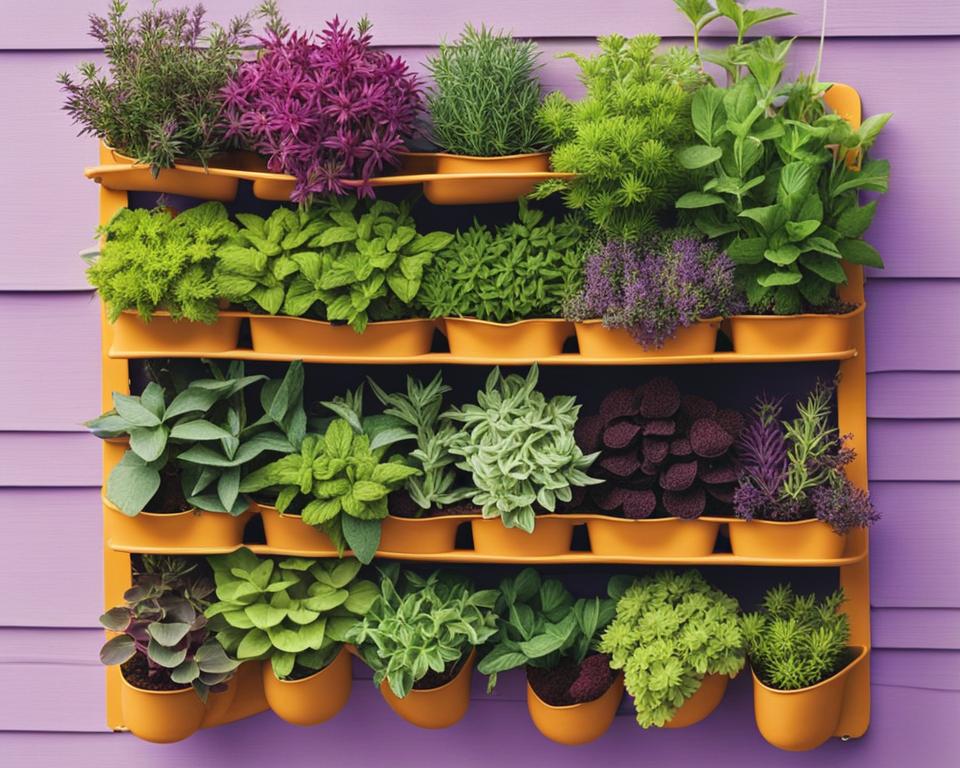
Adorn Your Windows with a Small Garden
If you have limited space but a window in your home, you can create a small garden by installing a window box. Use the box to plant flowers, herbs, or other plants and enjoy the beauty of your garden from inside. Window box gardens are a great way to add color and life to your home, especially in urban environments where views are often limited.
Window box gardens are not only visually appealing but also practical. They allow you to make the most of your vertical space and bring nature closer to you. Whether you have a sunny or shady window, there are plants that can thrive in different light conditions. For a vibrant and colorful display, consider planting a mix of annuals and perennials. Some popular choices for window box gardens include petunias, geraniums, marigolds, and herbs like basil and mint.
When creating your window box garden, make sure to choose a box that fits the size of your window sill. There are various options available, from traditional wooden boxes to modern metal or plastic containers. Ensure that the window box has proper drainage to prevent waterlogging and use high-quality potting soil to provide nutrients for your plants. Regularly water and fertilize your window box garden to keep your plants healthy and thriving throughout the seasons.
Benefits of Window Box Gardens
Window box gardens offer several benefits for urban dwellers. Here are a few reasons why you should consider adorning your windows with a small garden:
- Enhance your living space: Window box gardens add beauty and charm to your home, creating a welcoming atmosphere.
- Improve air quality: Plants act as natural air purifiers, filtering out pollutants and releasing oxygen.
- Access to fresh herbs and flowers: Having a window box garden allows you to conveniently harvest fresh herbs and flowers for cooking, decorating, or gifting.
- Connect with nature: Even in the midst of a bustling city, a window box garden helps you stay connected with nature and provides a sense of tranquility.
Overall, a window box garden is a simple and effective way to bring the beauty of nature into your living space. It allows you to create a mini oasis, regardless of the size of your home. So, why not transform your windows into a vibrant and refreshing urban window garden?
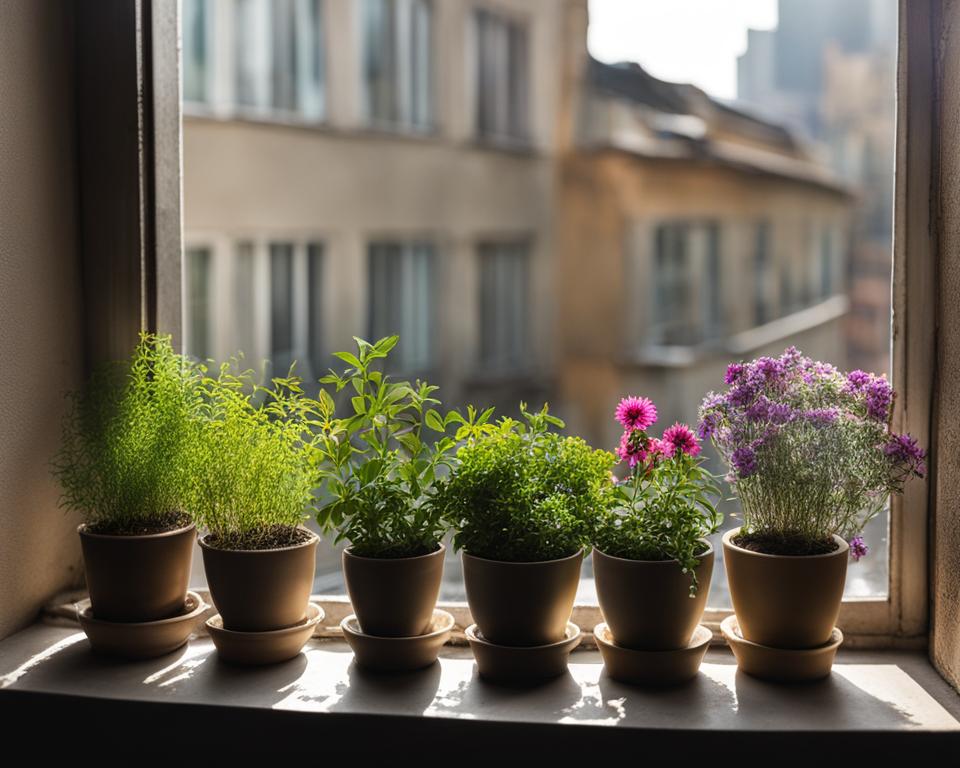
Utilize Wooden Pallets or Crates for a Vertical Garden
When it comes to creating a unique and space-saving urban garden, wooden pallets and crates can be your best friends. These versatile materials can be repurposed to create stunning vertical gardens that are not only functional but also add a touch of rustic charm to your outdoor space. By utilizing wooden pallets or crates, you can transform any empty wall or balcony into a flourishing garden oasis.
To get started, scrub the wooden pallets or crates clean to remove any dirt or debris. Once they are clean and dry, you can attach pots directly to the pallets or crates or use them as a base for planting. Make sure to choose sturdy and thick pallets or crates to ensure the longevity of your vertical garden.
For a visually appealing display, arrange the pallets or crates in a way that creates a visually interesting pattern or design. You can create different levels by stacking multiple pallets or crates on top of each other or arrange them in a staggered fashion. This will not only add depth to your garden but also provide more planting space.
Table: Comparison of Wooden Pallets vs. Wooden Crates for Vertical Gardens
| Feature | Wooden Pallets | Wooden Crates |
|---|---|---|
| Ease of Obtaining | Readily available for free or at a low cost | Can be purchased or repurposed |
| Size and Shape | Standard sizes, often rectangular | Various sizes and shapes |
| Strength and Durability | May be less sturdy and durable | Generally more sturdy and durable |
| Visual Appeal | Rustic and industrial look | Varies depending on the design |
| Versatility | Can be easily disassembled and repurposed | Can be used as standalone planters or stacked |
With wooden pallets or crates, the possibilities for your vertical garden are endless. You can paint or stain them to match your outdoor decor, or leave them in their natural state for a more rustic look. Additionally, you can also add hooks or shelves to the pallets or crates for additional storage or decorative elements.
So, if you’re looking for an innovative and affordable way to create a vertical garden in your urban space, consider utilizing wooden pallets or crates. Not only will you be able to maximize your planting space, but you’ll also have a beautiful and sustainable garden that will be the envy of your neighbors.
Get Creative with Mason Jars, Old Furniture, or Plastic Containers
When it comes to urban gardening, your imagination is the limit. Unleash your creativity by repurposing everyday items into unique planters for your green oasis. Not only will you add a touch of personality to your urban garden, but you’ll also contribute to sustainable living by repurposing materials that would otherwise go to waste.
One popular option for DIY planters is mason jars. These versatile glass containers can be easily transformed into charming herb gardens, adding a touch of freshness to your kitchen. Hang them near your window or attach them to a wooden board for a rustic look.
Do you have any old furniture lying around? Don’t throw it away! Instead, give it a new lease of life as a planter. An old dresser or bookshelf can become the centerpiece of your urban garden, with each drawer or shelf holding a different plant. Get creative with paint and patterns to make it truly unique.
Plastic containers are another excellent option for repurposing into planters. From old buckets to yogurt containers, the possibilities are endless. Paint them, add drainage holes, and fill them with soil to create a colorful and vibrant urban garden. Hang them on hooks or attach them to a fence for a vertical display of greenery.
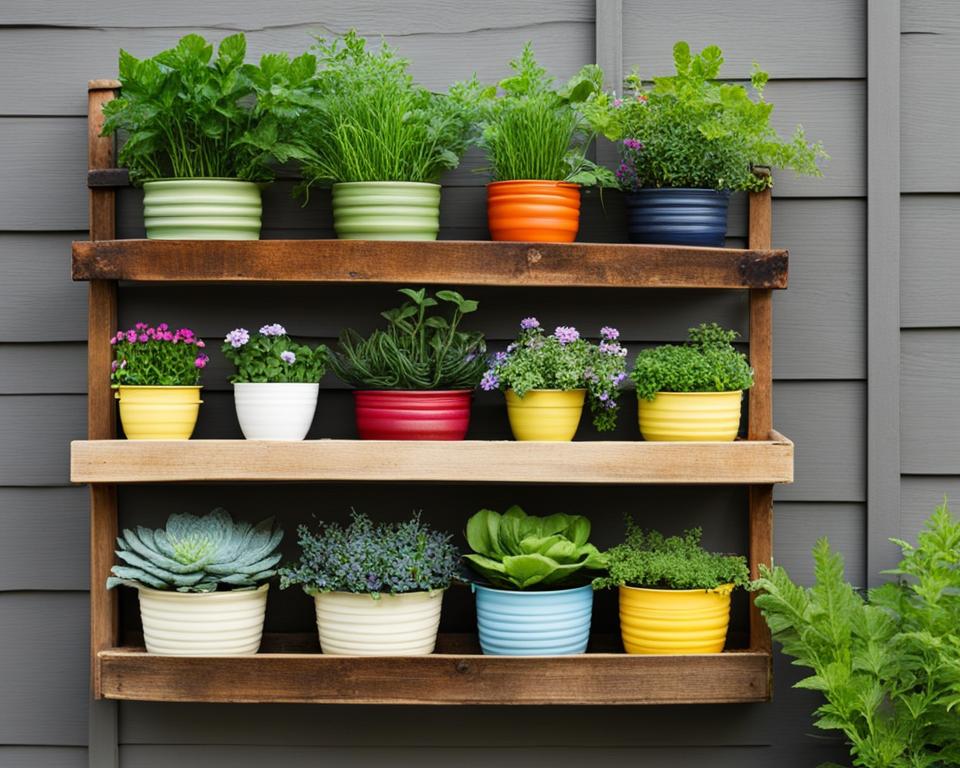
Transforming Trash into Treasure
Repurposing everyday objects for your urban garden is not only fun but also environmentally friendly. By giving new life to items that would otherwise end up in the landfill, you’re reducing waste and embracing sustainable living. So, next time you come across a mason jar, old piece of furniture, or plastic container, think about how it can be repurposed to create a beautiful and eco-friendly planter for your urban garden.
The Benefits of Urban Gardening
Urban gardening offers numerous benefits that go beyond just beautifying our living spaces. It provides us with access to fresh and healthy food, reduces greenhouse gas emissions, improves air and soil quality, and fosters a sense of community and well-being. Let’s explore these benefits in more detail:
Access to Fresh Food
One of the key advantages of urban gardening is the ability to grow your own food. By cultivating a small garden in your urban space, you can have a direct source of fresh produce right at your fingertips. This not only ensures the quality and freshness of the food you consume but also provides you with a sustainable and cost-effective alternative to store-bought produce. Whether it’s vibrant vegetables, flavorful herbs, or colorful fruits, urban gardening allows you to enjoy the taste and nutritional benefits of freshly harvested food.
Reduced Greenhouse Gas Emissions
Another important benefit of urban gardening is its contribution to reducing greenhouse gas emissions. By growing your own food locally, you eliminate the need for long-distance transportation and the associated carbon emissions. The produce from your urban garden has a significantly lower carbon footprint compared to food that travels hundreds or even thousands of miles to reach your plate. By reducing transportation emissions, urban gardening plays a vital role in mitigating climate change and promoting a more sustainable future.
Improved Air and Soil Quality
Urban gardens act as natural filters, improving air quality by absorbing carbon dioxide and releasing oxygen. Plants help remove pollutants and particulate matter from the air, resulting in cleaner and healthier environments. Additionally, urban gardening contributes to better soil quality by promoting microbial activity, enhancing nutrient cycling, and reducing erosion. By cultivating gardens in urban areas, we can create green oases that not only beautify our surroundings but also improve the overall environmental quality.
Overall, urban gardening offers a multitude of benefits that positively impact our health, environment, and communities. It enables us to have access to fresh and nutritious food, reduces greenhouse gas emissions, and enhances the quality of the air and soil around us. By embracing urban gardening, we can play an active role in creating a greener and more sustainable future.
Get Started with Urban Gardening Supplies
Are you ready to embark on your urban gardening journey? To ensure a successful start, you’ll need the right supplies and tools. Here are some essential items to consider:
Gardening Tools:
Invest in a set of quality gardening tools to help you maintain your urban garden. A spade, trowel, and pruning shears are essential for digging, planting, and trimming. A watering can or hose with a spray nozzle will make watering a breeze.
Seeds and Seedlings:
Choose a variety of seeds and seedlings that are suitable for your urban garden. Consider the space available and the amount of sunlight your garden receives. Start with easy-to-grow plants such as herbs, salad greens, or flowers for instant color.
Soil and Fertilizer:
Good soil is the foundation for a thriving garden. Use a high-quality potting mix or create your own by combining compost, peat moss, and vermiculite. Depending on the plants you choose, you may also need specific fertilizers to provide essential nutrients.
Containers and Raised Beds:
Since space is limited in urban environments, containers and raised beds are the ideal choice for growing plants. Choose containers that are deep enough to accommodate the roots of your plants and have proper drainage holes. If you have space, consider building raised beds for larger crops.
Starting an urban garden is an exciting endeavor that allows you to connect with nature, grow your own food, and create a green oasis in the heart of the city. With the right supplies and tools, you’ll be well-equipped to cultivate a thriving urban garden. Happy gardening!
The Tradition of Growing and Sharing Food
The tradition of growing and sharing food has been an integral part of human society for centuries. Ancient texts and cultural practices have emphasized the importance of community involvement in agriculture and the sharing of food. Community gardening, in particular, has played a significant role in fostering a sense of collective responsibility and promoting access to healthy, locally grown produce.
Community gardening is a form of urban agriculture where individuals come together to cultivate and maintain shared gardens. These gardens can be located in parks, vacant lots, or even on private properties. By working together, community gardeners not only grow their own food but also create opportunities for social interaction and connection.
In addition to providing fresh and nutritious food, community gardens contribute to the overall well-being of individuals and communities. The act of working together in the garden promotes physical activity, reduces stress, and improves mental health. Furthermore, community gardens serve as educational spaces, allowing gardeners to learn from one another and share their knowledge and experiences.
“Community gardens are not just about growing food; they are about growing communities.”
By engaging in community gardening and participating in food sharing initiatives, individuals can contribute to a more sustainable and inclusive society. The practice of growing and sharing food promotes food security, reduces food waste, and fosters a deeper connection with the natural world. It is a reminder of our innate relationship with the land and the importance of nurturing it for future generations.
The Benefits of Community Gardening
Community gardening offers a range of benefits beyond access to fresh food. Here are some key advantages:
- Promotes healthy eating and nutrition education
- Enhances community cohesion and social networks
- Improves mental health and well-being
- Enhances environmental sustainability and biodiversity
- Strengthens local food systems and reduces food miles
Engaging in community gardening allows individuals to actively participate in the food system, connect with their neighbors, and contribute to a more sustainable future. Through the tradition of growing and sharing food, we can cultivate not only nutritious produce but also strong and resilient communities.
References:
- Smith, J. (2020). The Importance of Community Gardening. Retrieved from https://www.example.com
- Anderson, L. (2018). Food Sharing and Community Gardening: Nourishing Communities. Retrieved from https://www.example.com
Conclusion
Urban gardening is not just a hobby or a trend; it is a movement towards more sustainable cities and resilient food systems. As we embrace urban gardening, we reclaim our connection with nature and take important steps towards improving food access and security in our communities. By growing our own food, we can reduce our reliance on long-distance transportation and contribute to the local food resilience movement.
Furthermore, urban gardening helps reduce our environmental impact by promoting green spaces and improving air and soil quality. As we cultivate our gardens, we create habitats for beneficial insects and pollinators, contributing to the overall biodiversity of our cities. Our gardens also serve as a reminder of the importance of the natural world in our daily lives.
But urban gardening is not just about the plants; it’s about the people too. By participating in the urban gardening movement, we have the opportunity to build tight-knit communities. We can share our knowledge, resources, and harvests, fostering a sense of camaraderie and collective responsibility. Through community gardens and shared spaces, we create spaces for connection and collaboration, bringing people together in a shared love for nature and sustainable living.
So, let’s roll up our sleeves, get our hands dirty, and join the urban gardening revolution. Whether we have a tiny balcony or a backyard, there are endless possibilities to create our own urban gardens and be part of a growing movement that envisions a greener and healthier future. Together, we can contribute to the development of sustainable cities, promote local food resilience, and make a positive impact on our environment and communities.
FAQ
What is urban gardening?
Urban gardening refers to the practice of growing plants, vegetables, and herbs in small spaces within urban environments, such as apartments, balconies, rooftops, or community gardens.
Why should I consider urban gardening?
Urban gardening allows you to create a beautiful and functional garden in small spaces, provides fresh produce, improves air quality, and promotes a sense of well-being.
How can I create a living wall in my home?
You can convert an existing wall into a green wall by attaching a frame or building a stand-alone structure. Use plants with small roots that can thrive on vertical surfaces, such as Money Plants, ferns, bromeliads, and spider lilies.
What is one pot gardening?
One pot gardening is a popular trend that allows you to plant multiple plants in a single container. It is a space-saving and convenient method that offers variety in your garden.
How can I recycle bottles for a vertical garden?
You can hang plastic bottles vertically or horizontally and fill them with soil to plant spices, herbs, or microgreens. Make sure to use thick plastic bottles and avoid using mineral water bottles.
Can I transform a shoe organizer into a plant organizer?
Yes, you can repurpose a shoe organizer by hanging it on a wall or railing, adding soil and compost, and planting flowers, microgreens, or herbs in the pouches. It maximizes vertical space and requires minimal effort.
How can I create a small garden on my windowsill?
You can install a window box and use it to plant flowers, herbs, or other plants. It allows you to enjoy the beauty of your garden from inside your home.
How can I utilize wooden pallets or crates for a vertical garden?
Scrub clean the wooden pallets or crates and use them as a base for attaching pots or planting directly. It is perfect for adding greenery to areas with limited space, such as balconies or walls.
Can I use unconventional items for my urban garden?
Yes, you can use everyday objects such as mason jars, old furniture, or plastic containers as planters. Get creative and place them on a ladder, open shelves, or window grills to create a unique garden space.
What are the benefits of urban gardening?
Urban gardening offers benefits such as access to fresh and healthy food, reduced greenhouse gas emissions, improved air and soil quality, and the creation of tight-knit communities.
What supplies do I need to get started with urban gardening?
Essential gardening tools such as a spade, trowel, watering can, and pruning shears are necessary. You may also need seeds, a watering system, and high-quality gloves.
What is the tradition of growing and sharing food?
The tradition of growing and sharing food has deep roots in our society. It fosters a sense of collective responsibility, promotes access to healthy food, and strengthens social connections.
Why is urban gardening a sustainable movement?
Urban gardening is a movement that aims to create more sustainable cities and resilient food systems. By embracing urban gardening, we can reclaim our connection with nature, improve food access and security, reduce environmental impact, and build tight-knit communities.

